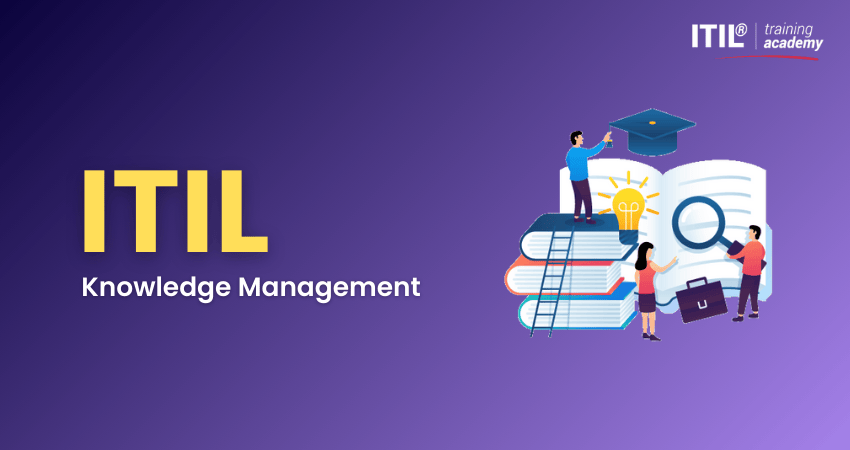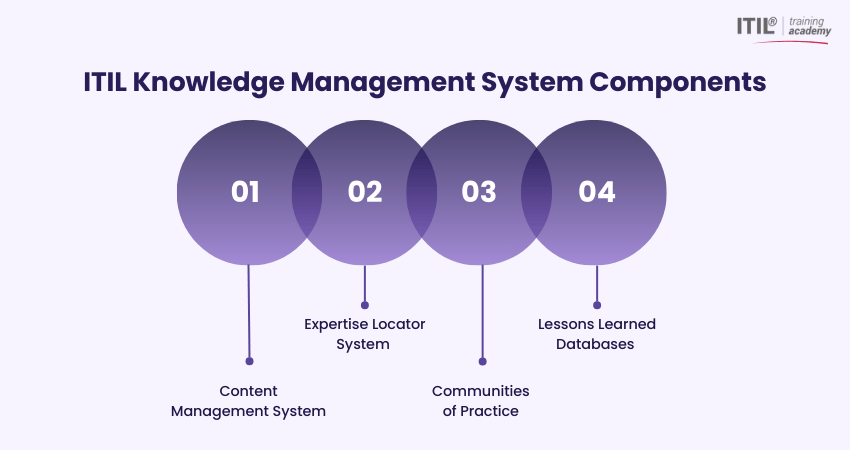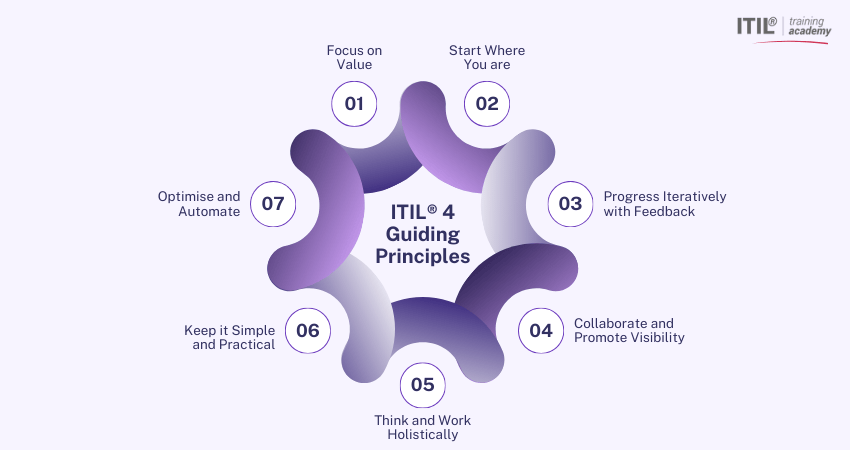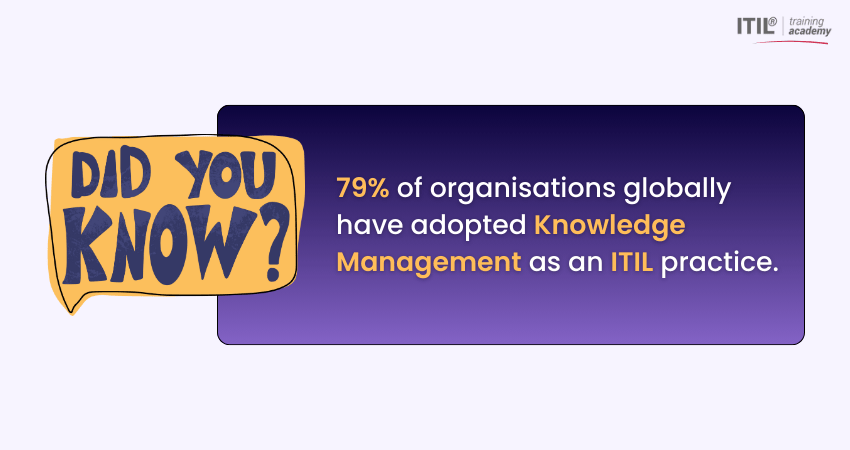
Author-Gary Moore
Last updated-Aug 22, 2025
IT Service Management (ITSM) continues to be the sturdy backbone of efficiency and innovation. But what makes it such an unparalleled powerhouse of IT? The answer lies in ITIL Knowledge Management, a repository of shared wisdom that helps resolve any IT hiccup in no time. It’s about unlocking collective intelligence to drive smarter decisions, faster resolutions and top-notch service delivery.
Essentially, ITIL Knowledge Management ensures the correct information reaches the right people at the right time. From reducing service downtime to turbocharging decision-making, it transforms scattered data into strategic assets. This blog breaks down its purpose, building blocks, best practices and more. So read on and keep your IT ecosystem smart and future ready.
Table of Contents
1) What is ITIL Knowledge Management?
2) Importance of ITIL Knowledge Management
3) Components of ITIL Knowledge Management Systems
4) Types of Knowledge in ITIL
5) Stages in ITIL Knowledge Management
6) Evolution of Knowledge Management in ITIL v2 to ITIL v4
7) Best Practices for Effective Knowledge Management
8) How to Implement Knowledge Management?
9) Conclusion
What is ITIL Knowledge Management?
Knowledge Management is about creating, organising, sharing, using, and maintaining information within an organisation and sometimes across industries. ITIL stands for Information Technology Information Library. According to ITIL 4, its goal is to make sure people get the right information, in the right format, at the right time, based on their access rights and relevant policies.
This involves collecting knowledge in many forms, whether it’s documented and formal or informal and experience based. A key component of Knowledge Management is the knowledge base, which is an online library where individuals can access information about a product, service, department, or topic.
Importance of ITIL Knowledge Management
In Information Technology, ITIL Knowledge Management is crucial. For instance, when a user reports an issue, a ticket is created and resolved by a technician and the solution is documented for future reference. Without a proper process, resolution times can be longer, downtime may increase, and even small issues can take too long to fix.
Here's why ITIL Knowledge Management is important:
1) Improved Decision-making: Easy access to historical data and best practices helps decision-makers make informed and reliable choices.
2) Reduced Redundancy: Past solutions and lessons learned are readily available, preventing repeated mistakes and saving time.
3) Improved Problem-solving: A well-organised knowledge base allows employees to find relevant information quickly, which speeds up troubleshooting.
4) Increased Innovation: Sharing both explicit and tacit knowledge improves collaboration and leads to new ideas and creative solutions.
5) Employee Development: Passing on knowledge to both experienced staff and juniors helps build skills and prepare them for greater responsibilities.
Components of ITIL Knowledge Management Systems
Here are the major components of an ideal ITIL Knowledge Management System:

1) Content Management System
A content management system is where all documentation and data are stored. It should be easy to navigate, searchable, and capable of handling large volumes of information. This ensures that users can quickly access the resources they need without unnecessary delays.
2) Expertise Locator System
Expertise Locator System known as an employee directory or skills inventory, this system helps you identify people within the organisation who possess specific expertise. The skills listed can include anything from technical abilities to professional experience. The more searchable and detailed the directory, the easier it becomes to locate the right person and facilitate knowledge sharing.
3) Communities of Practice
These are groups of employees who share common interests and come together to exchange knowledge and best practices. They foster collaboration, learning, and innovation across different teams. In large or remote organisations, digital platforms are often used to organise these communities, establish leadership roles, keep members engaged, and store the insights and resources they generate.
4) Lessons Learned Databases
This type of repository stores best practices, key insights, and tacit knowledge gained through past experiences. To be effective, it should be well-organised and easily accessible, ensuring that valuable lessons are applied in future projects rather than forgotten.
Become a Certified Sentinel of IT Security Management with our ITIL® 4 Practitioner Information Security Management Training - Sign up now!
Types of Knowledge in ITIL
Knowledge Management is an ongoing process of turning tacit or implicit knowledge into explicit knowledge that can be shared and accessed. To gain a better understanding, let’s examine the three primary types of knowledge.
1) Tacit Knowledge
It comes from personal experience, practice, or intuition. It lives in someone’s mind, making it hard to share. Examples include skills like speaking a language or making quick judgments. While it can be a major advantage, it’s also challenging to capture in a system.
2) Explicit Knowledge
This type of knowledge is documented, organised, and easy to access, such as manuals, reports, or FAQs. It’s simple to store in a Knowledge Management System, but it needs regular reviews and updates to stay accurate.
3) Implicit Knowledge
Implicit knowledge is found in processes, routines, and organisational culture. It might appear in formal documents, such as guidelines, but it’s really embedded in the way the organisation works on a day-to-day basis.
Stages in ITIL Knowledge Management
There are four stages involved in the realm of ITIL Knowledge Management. Let's explore them:
1) Data
Raw data refers to the unprocessed facts stored in databases. On its own, data has limited value, but when processed, it can be transformed into meaningful information.
2) Information
Data becomes information once it is given context. By categorising and interpreting the data, organisations can create structured information. This information is then communicated through reports, documents, or emails to highlight relevant details.
3) Knowledge
When team members analyse information, taking into consideration their own experiences, it becomes knowledge. Personal insights are responsible for transforming information into knowledge. This knowledge can be applied to inform decisions.
4) Wisdom
The gained knowledge can be applied in the context of IT service situations. The entire team is responsible for using their judgment and experience to apply the knowledge in a way that becomes wisdom.
Evolution of Knowledge Management in ITIL v2 to ITIL v4
From basic documentation in ITIL v2 to intelligent, value-driven practices in ITIL v4, Knowledge Management has evolved into a powerful pillar of IT service excellence. Let's explore this evolution in detail:
1) Knowledge Management in ITIL v2
Released in 2000, ITIL v2 focused primarily on Service Support and Service Delivery. It did not formally include a dedicated Knowledge Management process. While Microsoft adopted ITIL principles to develop the Microsoft Operations Framework (MOF), ITIL v2 itself was not converted into MOF. ITIL v2 laid the groundwork for structured IT Service Management but lacked the comprehensive lifecycle and knowledge-sharing mechanisms introduced in later versions.
2) Knowledge Management in ITIL v3
Launched in 2007 and revised in 2011, ITIL v3 introduced Knowledge Management as a formal process within the Service Transition phase. It emphasised the DIKW model (Data, Information, Knowledge, Wisdom) and the use of Service Knowledge Management System (SKMS) to support other ITSM processes. ITIL v3 structured Service Management around five lifecycle stages and expanded the framework to include 26 processes and functions.
3) Knowledge Management in ITIL v4
Released in 2019, ITIL v4 redefined processes as practices, including Knowledge Management as one of 34 practices. It integrates modern methodologies like Agile, DevOps, and Lean, and is built around the Service Value System (SVS) and Four Dimensions Model. ITIL v4 provides flexible, practical guidance for managing IT services in dynamic digital environments.

Best Practices for Effective Knowledge Management in ITIL
Knowledge is one of the most valuable assets for any IT team. When knowledge is openly shared, everyone stays aligned, works better together, and makes faster, smarter decisions. Here are some simple practices to encourage open sharing:
1) Centralise and Share Knowledge Effectively
Store all team knowledge in a centralised system, rather than scattering it across emails, tickets or personal notes. This will help you ensure the information is easy to find, access and update. This will encourage collaboration through shared editing, comments, and feedback.
2) Make Work Visible With a Project Poster
For every big initiative, create a project poster that outlines the goals and progress. Keep it updated and open so the whole team and stakeholders can give feedback and stay informed. This transparency builds alignment and keeps everyone moving in the same direction.

3) Focus on Brief Articles or Answers
Instead of long, complex documents, share concise articles or quick answers. Easy-to-read content helps teams learn faster and apply knowledge more effectively. Short, focused resources also encourage more people to contribute and share their expertise.
4) Champion a Culture of Knowledge Sharing
You must recognise and reward people who contribute valuable knowledge. Leaders should lead by example by regularly posting updates and engaging with teams directly through the knowledge platform.
Strategies, innovate and transform with ITIL® 4 Leader: Digital and IT Strategy Certification - Register now!
How to Implement Knowledge Management?
Follow these proven steps to put your Knowledge Management strategy into practice:
1) Identify Useful Knowledge: Focus on collecting information that adds value. Conduct a knowledge gap analysis to determine what employees need versus what they already know. Include FAQs, role-specific expertise and customer insights like survey results.
2) Organise and Store Knowledge: Decide how and where to keep information. Assign responsibility for managing it and ensure proper backup and recovery systems are in place.
3) Make Knowledge Easy to Access: Present knowledge in different formats to suit different learning styles. Use diagrams, tutorials, videos, graphics, images, webinars, and newsletters to make information clear and engaging.
4) Review and Update Regularly: Knowledge Management is an ongoing process. Track how information is used, verify its relevance, and remove outdated or unused content to maintain the effectiveness of your system.
Conclusion
ITIL Knowledge Management is the foundation of smarter teamwork and lasting success. By upholding knowledge as a shared resource, organisations can reduce errors, boost their efficiency and spark innovation. When knowledge flows openly, it transforms into collective wisdom that drives progress and shapes a resilient, future-ready organisation.
Looking to unlock the blueprint of IT excellence? Our ITIL® Foundation Level Training will guide you - Sign up now!
Most Recent
Date - Sep 20, 2025
Date - Sep 20, 2025
Date - Sep 20, 2025





 Back to
Topics
Back to
Topics

























